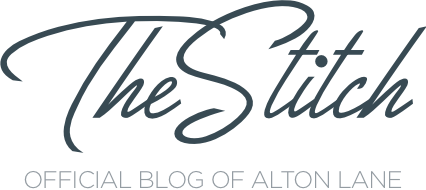It doesn’t matter if your first suit will be hand-selected off the racks of your local department store or hand sewn by a seasoned craftsman guided by your exact measurements. Buying your first suit, nevertheless, allows you to make meaningful decisions about fabrics, fits, and other details as you explore and your newfound menswear style. You may be looking to buy your first suit for an upcoming date, interview, or other formal occasion where you want to not only look, but dress, the part, and it’s important to understand the different personalization options available to you.
SUITING FABRICS
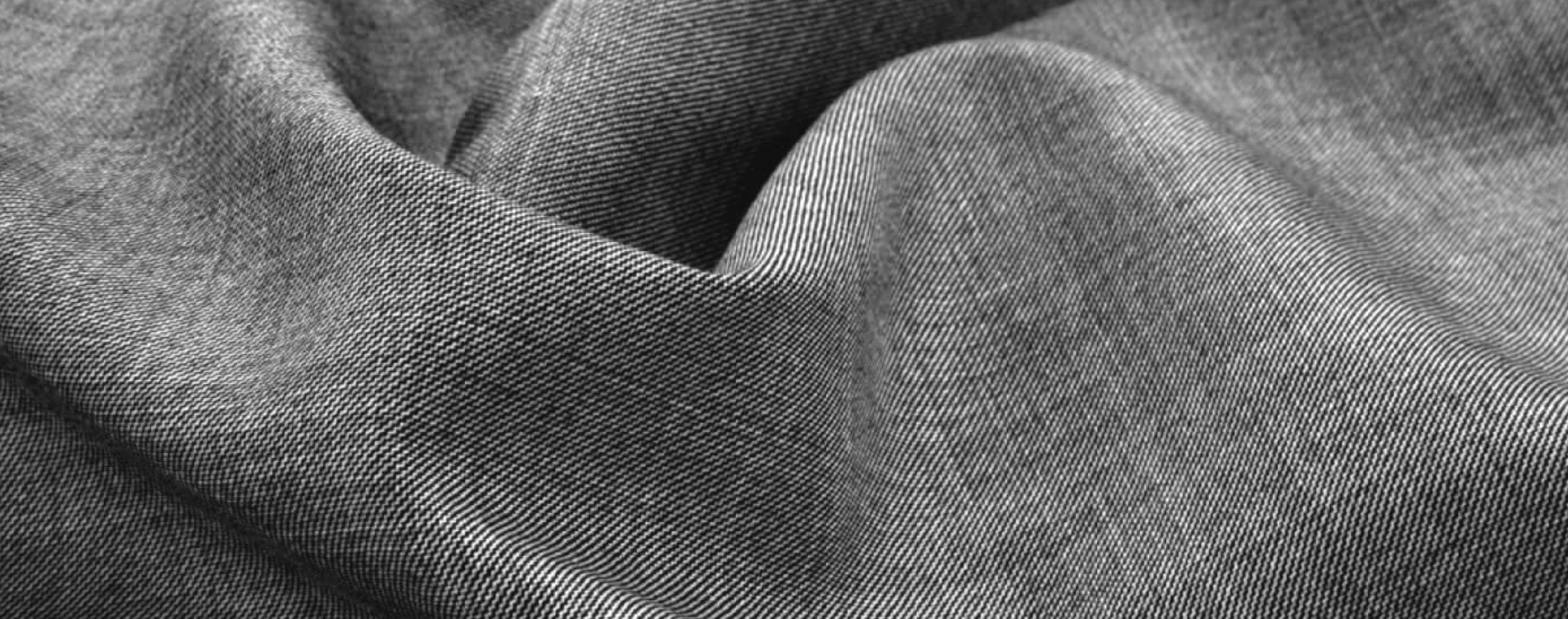
Common Fabrics
When making decisions about fabric, think about function, comfort, and environment. Ask yourself where and for how long you’ll wear this suit and how will the density affect how comfortable you are while wearing it.
Wool is hands-down the most popular fabric for suits and accommodates the complexities that go into making all different types of suits, be it off-the-rack, made-to-measure, or bespoke. Because it’s woven, the resulting, invisible air pockets make wool suits breathable and wearable in different climates.
In fact, there are different kinds of wool that sit on the lightweight/heavyweight continuum that allow for varying thermal-dependent comfort. Wool, in it’s most natural state, comes in two different varieties: woolen and worsted. Worsted wool imposes a polished look with it’s strong, fine, and resilient qualities, while woolens resemble the sweaters your father used to wear golfing on a cold day.
Similar in theory to a cotton product’s thread count, wool stock is known for its “super numbers” by which it is classified. These numeric indicators, popularly communicated by referring to the “S” of the wool, refer to the fineness of wool fiber measured in micrometers.
It is the fiber fineness that ultimately correlates with the wool product’s quality and performance, and, given that wool is the most common fabric for suits, the super numbers reveal a lot about the overall character of the suit that it composes. The higher the super number, the finer and smoother the yarn that was used in the wool fabric.
Other popular fabric choices for suits include cashmere for a luxurious shine, linen for a lightweight but a polished summer look, and cotton for an all-natural look with the versatility to be used in a variety of other common clothing fabrics like corduroy and seersucker. Silk also ranks well among first-time suit buyers because it has a delicate, unwrinkled appearance and is “silky smooth” to the touch.
While tweed is also commonly selected, it is a medium to heavy weight fabric, so it is largely favored by those looking to wear their suits in the winter months or year-round in colder climates, while polyester also presents limitations given it’s a man-made synthetic fiber leading to a less than breathable suit-wearing experience.
FABRIC PATTERNS

Common Fabric Patterns
Once you’ve decided on your fabric of choice, it’s time to get creative and welcome the possibility of working with patterned fabrics. It is this pattern that may distinguish your first suit from the others that follow as well as from the competition in the workplace—or on the dance floor.
From solids to stripes and the patterns known as bird’s eye and nailhead in between, each pattern represents a different level of formality and may reveal your sense of individuality. Plain weave patterns, for example, are a very basic weave but are very solidly constructed and can present an arrangement of colors that enliven an otherwise standard pattern.
Similarly, a sharkskin design is known for its light and dark, two-tone sequence that delivers an effect similar to a hopsack weave are known to resist the appearance of wrinkles. It’s important to remember that patterns are known for lightening the mood and carrying more casual notes than its solid counterparts.
If you do think that a solid pattern is for you, it is recommended to stick with navy blue, gray, charcoal and gray. It may be said that black is the most versatile color in fashion, but when it comes to buying your first suit, the versatility that these alternative colors offer allow for a more casual look while retaining a polished, conservative vibe.
Black should be reserved for tuxedos and other formal garments that only exit your closet for exclusive appearances. Your first suit in gray or blue will affirm your modern style and commitment to a sophisticated wardrobe.
Other Fabric Pattern Options
Like the fabric patterns explored above, the following pattern options are created with different weaving designs and sequences that involve various fabrics, colors, and constructions. It is recommended for first-timers that you consider why you decided it was time to buy your first suit in the first place before making critical decisions about fabric, color, and patterns.
All of the fabric patterns discussed here differ in subtle ways but have the power to change the overarching look of your first suit. Other fabric pattern options include the understated but classic woven houndstooth and herringbone, the popular wool varieties, and other patterns like glen check and pinstripes.

The herringbone design is known for its alternating colors woven in slanted lines while the houndstooth pattern is aptly named and resembles a checkerboard due to the sequence of four darkly colored threads and four lightly colored threads presented in abstract schemes.

Known as a “micro-check,” the houndstooth pattern is quite busy but works well for adventurous first-time buyers who are interested in mixing and matching their first suit with other garments.

Glen plaid is a popular choice for thinner body frames as its design can add the illusion of bulk. Glen plaid as been referred to as the “Prince of Wales check” and is comprised of differently sized checks usually in black, grey, and white, or muted, colors.
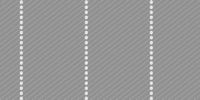
The attractive qualities of the very refined and popular pinstripe connote a formal sense of esteem and command, while its familial but less-defined counterpart, the chalk stripe expresses a keen sense of its origins as it’s named for the chalk that tailors use to mark their lines.
FIT
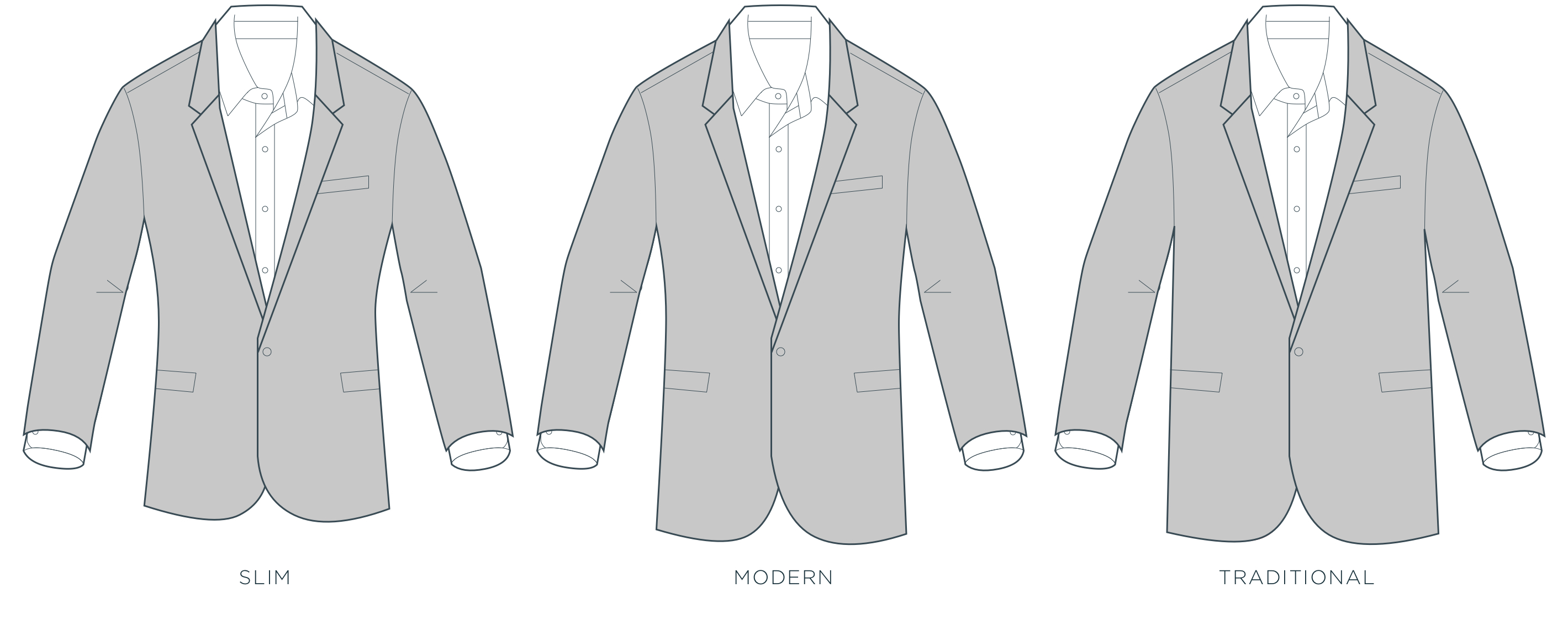
Slim vs. Modern vs. Traditional fit
When it comes to fit, there are three main categories: slim, traditional, and modern fit. Each style speaks to how the suit will frame your body, namely, your shoulders, torso, arms, waist, and corresponding height.
It is critical that both the collar and torso fit be comfortable and be functional enough to allow buttons to be fastened while maintaining just enough room for your future toddler’s pint-sized fist to fit inside your jacket, thereby indicating that the jacket is a perfect fit.
Then there are your shoulders, well-positioned to indicate assuredness if only adorned with a well-fitting suit jacket. Your shoulders, in line with your posture, reveal the degree of confidence that you face the world with, and your suit jacket needs to protect the reputation of those confident shoulders by molding nicely without room for any extra material that may create an impression of pads.
Slim fit suits are contoured to your slim frame with enough room for movement. With their shorter jackets and slim fit pants that have narrow lines and less wide leg openings that modern or traditional fit trousers, slim fit varieties combine short, narrow, and slim presentations to accommodate trim males with lean builds.
Modern fit suits have more room than the slim fit suits and feature a modern shoulder with a non-restrictive fit that is complemented by a slim lapel that creates clean lines and a contemporary, fashion-forward look. With its flat front and narrow legs, the absence of a cuff or break—that is, how much of the pant leg is folded above where the bottom of the trousers’ fabric meets your shoe.
And your traditional fit is known for generous cuts to allow for more movement while maintaining a polished construction that espouses a commitment to fit and function. Traditional fit suits typically feature regular fit pants that sit at the waistline and present a natural, comfortable fit among men of small- to medium- builds.
DETAILING OPTIONS
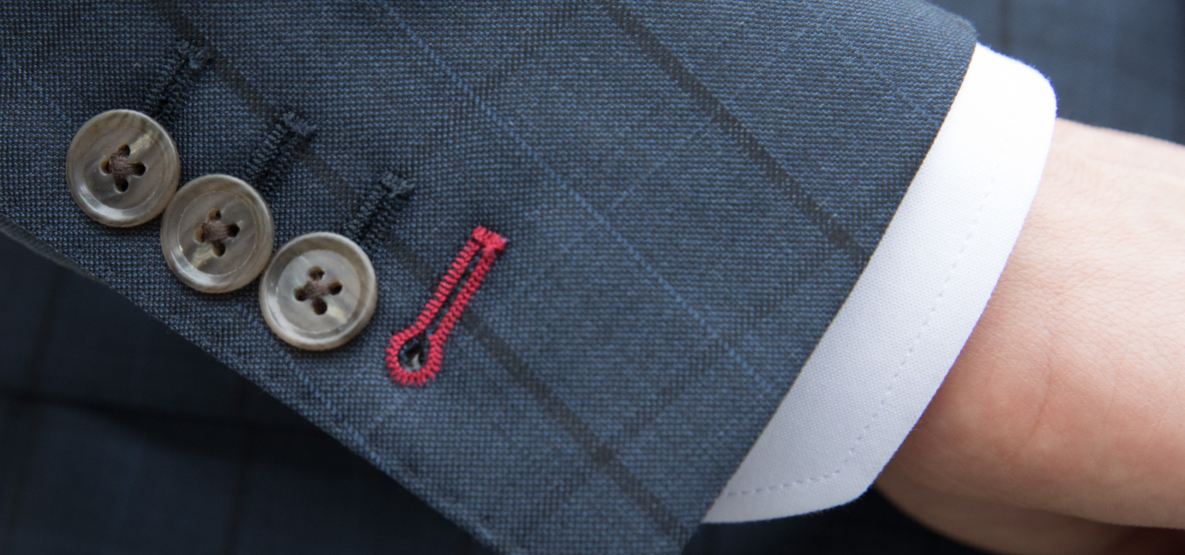
Pockets
As mentioned, the real impact of your first suit is in the details. So, whether you want to play with your pocket style and present as more casual with patch pockets that resemble what you see on most blazers or lean more formal with sleek jetted pockets, there are assorted possibilities to explore when buying your first suit.
While patch pockets render an effortless look with its “stuck-on” appearance, the angled pocket type is known to take attention away from what might be a round belly underneath the suit jacket. Alternatively, jetted pockets impose a formal appearance with their thin slits and clean lines.
There are grave differences between the different pocket styles available to you as you design your first suit, and these somewhat functional aspects of a suit jacket known as pockets can significantly alter the overall look because each pocket type speaks a different language, so it’s important to understand how they differ and complement the other detailing selections you’ve made for your first suit.
Vents
 Vents refer to the openings or slits in the back of your suit jacket. They create the flexibility and extra mobility its wearer has to move about. Single vents feature one slit in the center of the back of the suit jacket and is most common in off-the-rack and made-to-wear options due its lower cost and shorter turnaround time on the part of the manufacturer. The use of single vents is in line with a preference for function over form.
Vents refer to the openings or slits in the back of your suit jacket. They create the flexibility and extra mobility its wearer has to move about. Single vents feature one slit in the center of the back of the suit jacket and is most common in off-the-rack and made-to-wear options due its lower cost and shorter turnaround time on the part of the manufacturer. The use of single vents is in line with a preference for function over form.
Double or middle vent styles work to slim and heighten the appearance of the wearer by featuring two vents on the sides. A popular choice for bespoke garments, the double vent is known for its sophisticated, formal appearance over the other vent styles. Of course, some suits do not include vents at all in favor of allowing the suit jacket to snugly fit the torso, an option some wearers with smaller builds might elect.
Lapels
Your lapel options are, and should be, limited, as they should correlate with style and widths of the ties that will be worn at the same time. These folded flaps of fabric on the front-side of your suit are characterized by their fall and curl tendencies depending on how the cloth is cut and narrows from the collar to the first button.
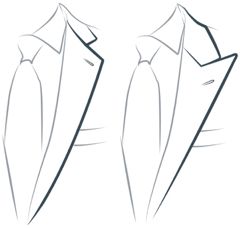 Given that the notch lapel is the most popular for its versatility among single-breasted suit jackets, blazers, and sportcoats, the notch lapel is recommended for your first suit. It’s 75-90° angle at the bottom of the collar creates a chic aesthetic while retaining an uncomplicated look that is well-suited for different environments of varying formality.
Given that the notch lapel is the most popular for its versatility among single-breasted suit jackets, blazers, and sportcoats, the notch lapel is recommended for your first suit. It’s 75-90° angle at the bottom of the collar creates a chic aesthetic while retaining an uncomplicated look that is well-suited for different environments of varying formality.
The peaked lapel is a more formal selection and require the most skill in assembling the defined edges that double-breasted suits are known for. Alternatively, the rounded edge of a shawl collar should be reserved for tuxedos or other menswear required at black tie events or high-profile galas. The irregular lines of the notch and peak lapel collars are better aligned with the needs for a first-time suit buyer.
Buttons
And finally, if after making all the other decisions about how to accessorize your first suit, you find that you appreciate the decorative value that different button materials and color offer, you will be happy to know that you have your pick here as well. There are buttons made of polyester and the naturally striking appearance of horn, and the chromatic qualities of these and other button types range from red to gradient builds of grey and every color in between. It is recommended that you choose black or brown horn or a nice mix for your first suit’s buttons, while avoiding brass, mother of pearl, and gold.
FIND YOUR PERFECT FIT
We invite you to discover a new world of bespoke, where clients have the opportunity to design every detail of their garment. Select each element, from the fabric to the color of the stitching on your buttons, with a drink in hand – the way it was meant to be.

